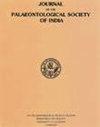利用不同地表样品反演孢粉响应,重建印度东北部阿萨姆(印缅地区)巴拉克山谷的古生态和古气候
IF 0.6
4区 地球科学
Q4 PALEONTOLOGY
Journal of the Palaeontological Society of India
Pub Date : 2023-10-26
DOI:10.1177/05529360231205316
引用次数: 0
摘要
在一个地区不同植被类型下建立现代花粉类似物是必要的,否则很难根据过去的环境和古气候准确地解释任何地区的化石花粉组合。我们分析了来自阿萨姆邦南部Karimganj地区的森林、农田、湿地和河流遗址的30个表层土壤和沉积物样本的现代花粉数据集,以了解最近花粉组合与巴拉克山谷植被模式之间的联系。总体花粉资料反映了该地区在温暖湿润气候下,由Syzygium、Schleichera、Terminalia、Lagerstroemia、Duabanga、Sapotaceae、Ilex、Mesua和Schima组成的热带湿润落叶半常绿林对降雨变化的响应。大戟科和旋花科的存在表明该地区及其周围季风活动频繁。观察到当地草本植被与花粉之间的密切关系。谷类花粉的稳定分布(平均为18.67%)以及芸苔科、芫荽科和茄科等其他文化花粉类群表明山谷地区农业活动强烈。利用多变量主成分分析(PCA)和箱形图对地表样品花粉频率分析的量化数据进行了分析,结果清楚地揭示了植被类型的显著差异和相似性。因此,已经开始尝试精确地观察现代花粉在不同沉积环境下沉积的行为模式,这反过来可以帮助评估农业实践的范围以及原始森林和周围地区退化的深度。这个现代训练数据集还可以帮助精确重建巴拉克山谷地区过去的气候和植被变化。还将评估区域孢粉数据与印度次大陆和印度-缅甸其他区域的相关性,以便更好地解释。本文章由计算机程序翻译,如有差异,请以英文原文为准。
Palynological response deduced through spatially distinct surface samples to reconstruct palaeoecology and palaeoclimate of the Barak Valley, Assam (Indo-Burma region), northeast India
Establishing modern pollen analogues under various vegetation types in a location is necessary without which it is difficult to accurately interpret fossil pollen assemblages in any region in terms of the past environment and palaeoclimate. We have analysed the modern pollen dataset of 30 surface soil and sediment samples from the forested, cropland, wetland and river sites of the Karimganj District in south Assam, to comprehend the connection between the recent pollen assemblage and the vegetation patterns in the Barak Valley. The overall pollen data reflect the tropical moist deciduous and semi-evergreen forest comprising Syzygium, Schleichera, Terminalia, Lagerstroemia, Duabanga, Sapotaceae, Ilex, Mesua and Schima under a warm and humid climate in response to rainfall variations in the region. The presence of Euphorbiaceae and Convolvulaceae inferred high monsoonal activity in and around the region. A robust relationship between local herbaceous vegetation and pollen was observed. The steady occurrence of cereal pollen (average 18.67%) along with other cultural pollen taxa like Brassicaceae, Coriandrum and Solanaceae illustrate intense agricultural activity around the valley areas. Multivariate principal component analysis (PCA) and box plot were applied to the quantified data obtained from pollen frequency analyses of the surface samples which clearly revealed a significant variation and similarity in vegetation types. Thus, an attempt has been commenced to precisely observe the behavioural pattern of modern pollen deposition in a varied depositional setting, which could, in turn, help in assessing the expanse of agricultural practices and the depth of deterioration of pristine forests and surrounding areas. This modern training dataset could also help in the precise reconstruction of past climate and vegetation shifts in the Barak Valley region. A correlation of regional palynodata with other regions of the Indian subcontinent and Indo-Burma will also be assessed for better interpretation.
求助全文
通过发布文献求助,成功后即可免费获取论文全文。
去求助
来源期刊

Journal of the Palaeontological Society of India
PALEONTOLOGY-
CiteScore
1.10
自引率
16.70%
发文量
0
期刊介绍:
The journal is devoted to the publication of original papers and review articles dealing with all aspects of Paleontology, Paleobotany, Stratigraphy, Geochronology, Anthropology and Pre-history.
 求助内容:
求助内容: 应助结果提醒方式:
应助结果提醒方式:


